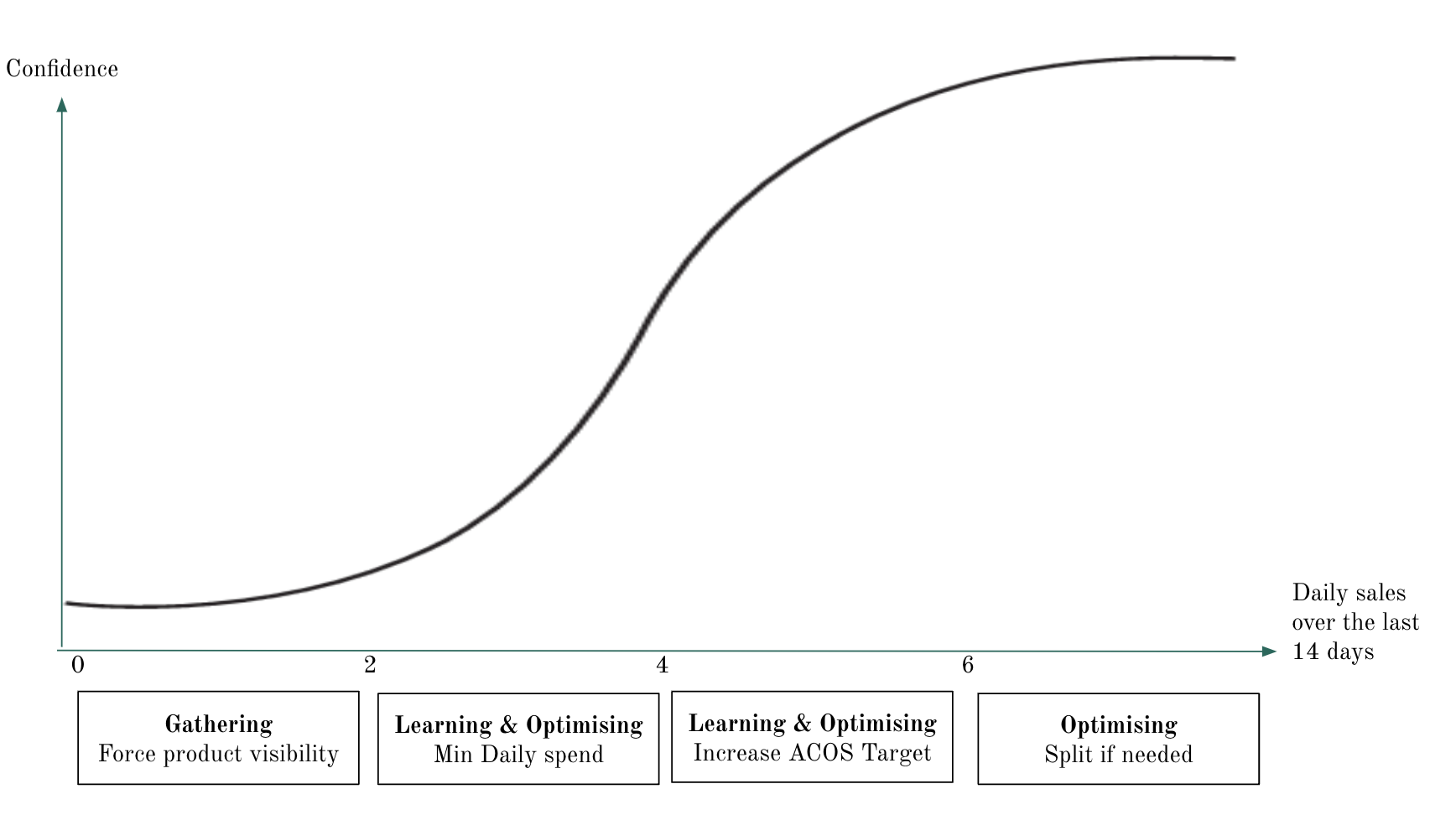A simple structure for sponsored product strategies on ACOS Target
The algorithm's top priority is to respect the ACOS TARGET. It spends money until it reaches the ACOS TARGET. For your first strategies, you should aim for gathering data to increase the daily orders.
- Daily order is the average orders per day for the past 14 days
- ASINs are margin-alike when their relative margin is close (e.g., 20 % and 22 % are close). It is up to your interpretation to define what is close enough.
Split the catalogue into strategies
The algorithm optimises the sales based on previous conversions. The learning curve reaches its maximum confidence around 10 daily orders for a strategy.
You should split your catalogue into strategies by following these principles in the order:
- Each strategy has minimum 2 daily orders
- Each strategy contains margin-alike ASINs
- Each strategy contains category-alike ASINs.
Just like a ladder, you need to stand one a rung to catch the next rung. Each strategy needs to comply with a step before moving to the next step (splitting more).
Of course, you can skip a rung/jump a step but you should not catch a lower rung afterwards.
For example, you can split your catalogue into strategies that have a minimum of 2 daily orders AND THEN split by category. But you should not split by margin afterwards.
If you want to split by margin, you need to forget the split by category you made previously and start again from the 2 daily orders.
The perfect strategy has a minimum of 10 daily orders AND its ASINs are margin-alike AND the ASINs are category-alike! It is the last rung.
Daily orders
You should group ASINs based on their daily orders. A strategy should have at least 2 daily orders! You can group the ASINs with low daily orders together in a force product visibility strategy.
You can split your strategies into smaller strategies as long as no strategy would have had less than 6 daily orders. You can create 1 product group for analysis before creating any strategy. Afterwards, you can filter the product group in SALES & ADVERTISING to make sure it has at least 6 daily orders.
The goal is to have your strategies in the last stage of the learning curve (Optimising) before splitting your strategy into smaller ones.
 Margin-alike
Margin-alike
Once a strategy has more than 10 daily orders, you should split your strategies by margin. The most common case is to have 3 product groups used in 3 different strategies:
- LOW MARGIN
- MEDIUM MARGIN
- HIGH MARGIN
Before splitting, you can create product groups with the ASINs you want to put in another strategy. Then, you need to filter the product group in SALES & ADVERTISING to check the daily orders for both product groups:
- The new product group
- The existing product that does not contain the ASINs of the new product group
If the existing strategy would still have had at least 2 daily orders without the ASINs in the new product group, you can keep it. Otherwise, you should pause it and create a force product visibility strategy instead.
You can create a sponsored product strategy for the new product group and apply the ACOS the product group used to have (cf: SALES & ADVERTISING)
Category-alike
A strategy can contain ASINs that are very different. Each bid is independent and the algorithm focus on the most relevant keywords and products only.
For example, you can group together teacup and computers in a strategy without consequences.
There is one exception: tactics. A tactic is a bunch of keywords and products (segment) you set up in a strategy to force the algorithm to bid on it. Tactics can contain anything (example: your brand name as phrase targeting OR a competitor's ASINs)
If you want to have control over the keywords and product the algorithm targets for you, you have 2 alternatives:
- You split your catalogue based on ASINs' categories, create the strategies and create the tactics. In this case, follow this tutorial on traffic control
- You DO NOT split your catalogue based on ASINs' categories. But, you add seed keywords and products in the catalogue. In this case, you will not have control over the ACOS or spending per keyword or product.
It is necessary to split by category for strategies that contain tactics with generic keywords or products
![m19-transparent.png]](https://help.m19.com/hs-fs/hubfs/m19-transparent.png?height=50&name=m19-transparent.png)